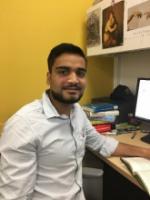
Mayank Chadha is a PhD student in the Department of Structural Engineering at the University of California, San Diego. He is currently working under the guidance of Professor Michael D. Todd. Mayank received his Bachelor degree with honors in Civil Engineering from the PSG College of Technology, Anna University, India in 2014. He received his M.S degree in Structural Engineering from UC San Diego in 2016.
His research interest is to exploit differential geometry of manifolds along with variational mechanics to advance the Cosserat rod and plate theory. He is currently working on the conservation laws of deformable bodies utilizing Noether’s theorem and Lie symmetries. His research with Professor Todd on the application of micropolar elasticity and Cosserat rod theory on shape sensing method has been published in ASME Journal of Applied Mechanics.
The full-field deformed shape reconstruction of a slender object like pipelines, tethers, mooring cables, surgical tubing and others is desirable for many applications. This work aims at developing an algorithm that determines the three-dimensional global displaced shape of the slender structures from a limited set of scalar surface strain measurements. It is a comprehensive approach that captures the effect of curvature, shear, torsion and elongation. A common behavior of the targeted structures is that they are subjected to small strains but arbitrarily large deformations. Such a scenario occurs in essentially one-dimensional structures, implying that the cross-sectional dimension is much smaller than its length. This theory utilizes the strain measures and is independent of the material of the body.
This work addresses two broad aspects- first it approximates the uniaxial strain (in each direction) anywhere in the structure and second it reconstructs the deformed shape, given a set of strain values. The deformed shape of the Cosserat beam (single manifold problem) is defined by the shape of the midcurve (influenced by elongation and bending) and the cross-sectional orientations (effected by shear and torsion). Therefore, the goal of the research narrows down to relate the global deformation parameters (like elongation, curvature, shear angles, position vector of the midcurve and the directors) to the limited number of uniaxial surface strain values. The approach utilizes Cosserat rod theory, geometrically exact beam theory and exploits a localized linearization approach that helps obtain a local basis function set for the displacement solution in the Cosserat frame.
Lindsay Walton
(858)822-3273
lwalton@ucsd.edu
